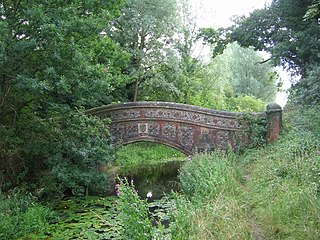
Knettishall Heath is a 91.7 hectare biological Site of Special Scientific Interest west of Knettishall in Suffolk. A larger area of 176 hectares is the Knettishall Heath Nature Reserve, which is managed by the Suffolk Wildlife Trust.

Streatham Common is a large open space on the southern edge of Streatham in the London Borough of Lambeth. The shallow sloping lower (western) half of the common is mostly mowed grass, and the upper (eastern) half is mostly woodland with some small areas of gorse scrub and acid grassland. The eastern half has been designated a Local Nature Reserve.
The Avon Wildlife Trust aims to protect and promote wildlife in the area of the former county of Avon — now Bath and North East Somerset, Bristol, North Somerset and South Gloucestershire, in England. It has its headquarters in Bristol and runs wildlife centres at Folly Farm, Somerset and Feed Bristol, Frenchay, North Bristol.

Blackpool Illuminations is an annual lights festival, founded in 1879 and first switched on 18 September that year, held each autumn in the British seaside resort of Blackpool on the Fylde Coast in Lancashire. Also known locally as The Lights or The Illuminations, they run each year for 66 days, from late August until early November at a time when most other English seaside resorts' seasons are coming to an end. They are 6.2 miles (10 km) long and use over one million bulbs. The display stretches along the Promenade from Starr Gate at the south end of the town to Bispham in the north.

Bispham is a village on the Fylde coast in Lancashire, England, a mile and a half north of Blackpool town centre.
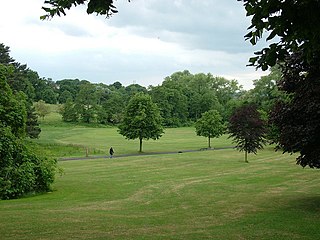
Holywells Park is a 67-acre (270,000 m2) public park in Ipswich, England situated between Nacton Road and Cliff Lane, near to the Ipswich Waterfront.

The Great North Wood was a natural oak woodland that started three miles (4.8 km) south-east of central London and scaled the Norwood Ridge. At its full extent, the wood's boundaries stretched almost as far as Croydon and as far north as Camberwell. It had occasional landownings as large clearings, well-established by the Middle Ages such as the hamlets of Penge and Dulwich.
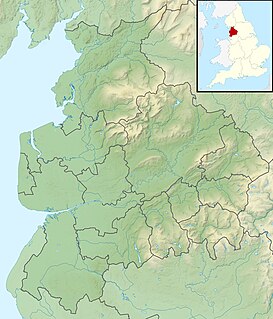
Beacon Fell is a fell in the civil parish of Goosnargh in Lancashire, England. The high ground, which rises to 266 m (873 ft), has been a country park since 1970. It is situated within the south westerly part of the Forest of Bowland, an Area of Outstanding Natural Beauty.

Ninesprings is a country park situated in the South East of Yeovil, Somerset, the United Kingdom. It is the largest country park in South Somerset, spanning over 20 acres (8.1 ha).

Salisbury Woodland Gardens is an open space located in the east of Blackpool, flanked by East Park Drive and Woodside Drive and linking Blackpool Zoo with Stanley Park. Known simply as the 'Woodland Gardens' to local people, the site was acquired in 1924 by Blackpool Corporation and was originally developed as a shelter belt for the adjacent Stanley Park Golf Course. The gardens were later developed in the 1940s as an arboretum and public open space for all to enjoy. It was renovated in 1967 by Peter Perry and his 'Flying Squad. Popular once as a wedding photograph location, the site went into decline during the 1990s. The council's Ranger Service manage and protect the gardens which they took over in September 2006 and have been funding and undertaking the restoration of the woodland. In 1967, Parks Director Norman Leach appointed gardener Pete Perry and his Flying Squad of gardeners to plant up the gardens. All plants, were grown from seed in the greenhouses at Stanley Park, and planted en masse. Extra shrubs, including azalea were also planted.
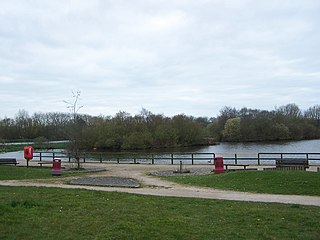
Kincraig Lake Ecological Reserve is a wildlife reserve located in Bispham in Blackpool on the Fylde coast, Lancashire, England. It is owned by Blackpool Council.

Moor Park is a municipal park located in the Moor Park area of Bispham in Blackpool on the Fylde coast in Lancashire, England.

Para Wirra Conservation Park is a 1,417-hectare (3,500-acre) protected area located in the foothills of the Mount Lofty Ranges in the northern end of the Adelaide metropolitan area in South Australia. The conservation park is part of a larger, 2,573-hectare (6,360-acre) block of contiguous native vegetation, the remainder of which is owned by PIRSA Forestry, SA Water and private landholders.

Sydenham Hill Wood is a ten-hectare wood on the northern slopes of the Norwood Ridge in the London Borough of Southwark. It is designated as a Local Nature Reserve and Site of Metropolitan Importance for Nature Conservation. With the adjacent Dulwich Wood, Sydenham Hill Wood is the largest extant tract of the ancient Great North Wood. The two woods are formed from coppices known as Lapsewood, Old Ambrook Hill Wood and Peckarmans Wood after the relocation of The Crystal Palace in 1854 and the creation of the high level line in 1865.
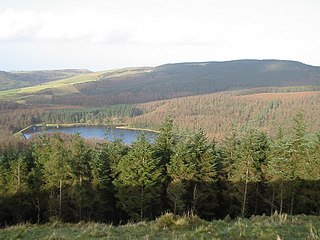
Macclesfield Forest is an area of woodland, predominantly conifer plantation, located around 3 mi (5 km) south east of Macclesfield in the civil parish of Macclesfield Forest and Wildboarclough, in Cheshire, England. The existing woodland is the last substantial remnant of the Royal Forest of Macclesfield, a once-extensive ancient hunting reserve. The area also includes two reservoirs, Trentabank and Ridgegate. Macclesfield Forest lies on the western edge of the Peak District, within the South West Peak, and is partly inside the boundary of the National Park. The hills of Tegg's Nose and Shutlingsloe stand to the north west and south east, respectively; the moorland of High Moor lies to the south and the Goyt Valley lies to the west. Nearby villages include Langley and Wildboarclough.
Brecknock Wildlife Trust is a former wildlife trust covering the vice county of Brecknockshire in Wales. The Trust was founded in 1964, with a network of volunteers carrying out most of its work. No full-time conservation officers were in post until 1987. Heritage Lottery funding helped the Trust to expand and a bequest of £1,000,000 in 2003 resulted in the appointment of a Reserves Officer. In April 2018 it merged with The Wildlife Trust of South and West Wales.
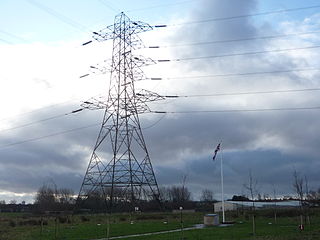
Fylde Memorial Arboretum and Community Woodland is a site of remembrance at Bispham, Blackpool, Lancashire, England. It is the only one of its kind outside the National Memorial Arboretum, Alrewas, Staffordshire.
Gunnergate Hall was a mansion house with grounds in the south of Middlesbrough in North Yorkshire, England.
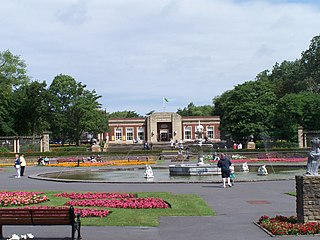
Stanley Park is a public park in the town of Blackpool on the Fylde coast in Lancashire, England. It is the town's primary park and covers an area of approximately 104 hectares. The park was designed to include significant sporting provisions, along with formal gardens, a boating lake and woodland area. It was designed and built in the 1920s, under the eye of Thomas Mawson.

Fix the Fells is a conservation programme set up as a partnership between the Lake District National Park, National Trust, Natural England, Lake District Foundation, Friends of the Lake District and Cumbria County Council. Fix the Fells carries out work to combat erosion of footpaths in the English Lake District.



















